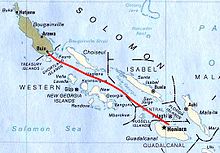Tokyo Express
Tokyo Express was the US designation of during the Pacific War propelled Japanese troops convoys to Guadalcanal , which by the Japanese Nezumi Yuso ( 鼠輸送 were called, dt. "Mice Transport"). The preferred route for these fleets , mostly consisting of fast destroyers , was the so-called slot - the shallow sea between Bougainville , Santa Isabel and the island of Savo . The trips took place at night in order to remain undetected as possible. The person in charge on the Japanese side was Rear Admiral Tanaka Raizo .
On August 21, 1942, the Japanese 28th Infantry Regiment landed on Guadalcanal with the first Tokyo Express. From this the Battle of Tenaru developed .
Another incident, in which eight Japanese destroyers were intercepted by five American cruisers and six destroyers, led to the battle of Tassafaronga on November 30, 1942. The battle in the Kula Gulf also resulted from the encounter of American naval units with ships of the Tokyo Express on Returned July 6, 1943. Shortly afterwards, opposing ships fought on July 13 at the Battle of Kolombangara .
On November 25, 1943, the officially last Tokyo Express, consisting of five destroyers, three of which were loaded with troops , drove to Rabaul . American destroyers awaited him, and three Japanese ships were sunk during the Battle of Cape St. George .
Japanese use of destroyers as transport ships
Admiral Isoroku Yamamoto authorized the use of faster destroyers as transport ships at night to avoid detection and air strikes. The supplies were packed in sealed steel drums. Several barrels were tied together. Since the destroyers were not equipped for unloading supplies, they were simply thrown into the water. The barrels swam ashore with the tide or were salvaged by barges. On a typical December night, 1,500 barrels were thrown into the sea by the Japanese Navy. Only 300 barrels could be recovered.
Sinking of John F. Kennedy's PT speedboat
On August 2, 1943, the speedboat PT-109 , commanded by John F. Kennedy , was rammed and sunk by the destroyer Amagiri during an action against the Tokyo Express . Two crew members were killed, Kennedy survived injured.
Web links
Individual evidence
- ^ History of USMC Operations in WWII, Vol I, Chapter 9: Final Period, 9 December 1942 to 9 February 1943
- ^ Robert Dallek: John F. Kennedy. An unfinished life. DVA, Munich 2003, ISBN 3-421-05200-X , p. 88.

